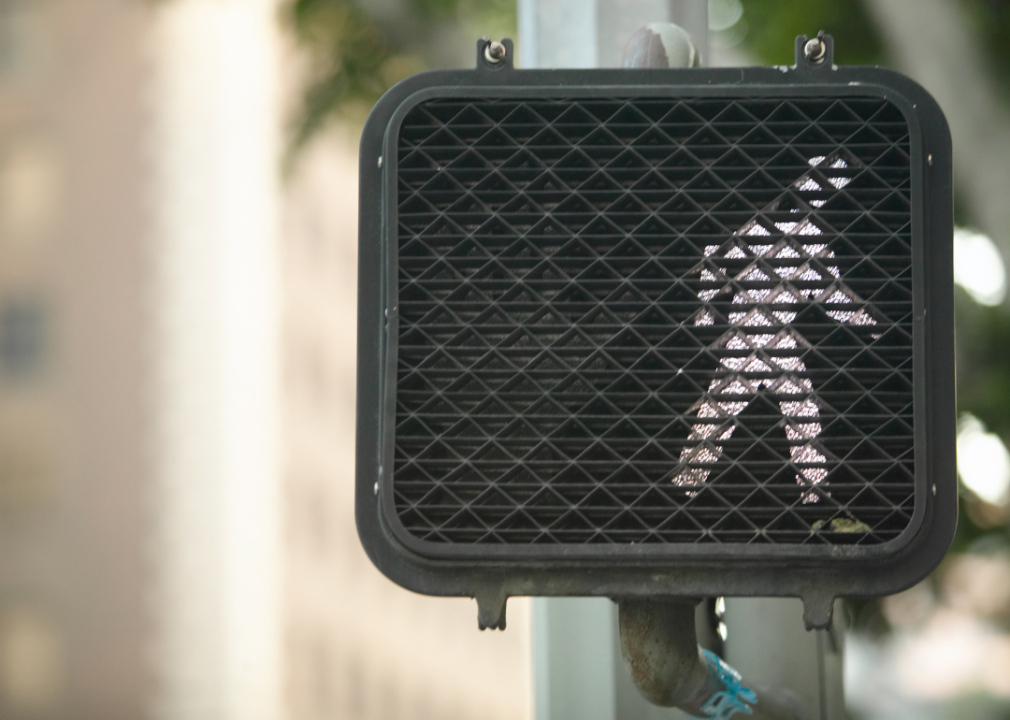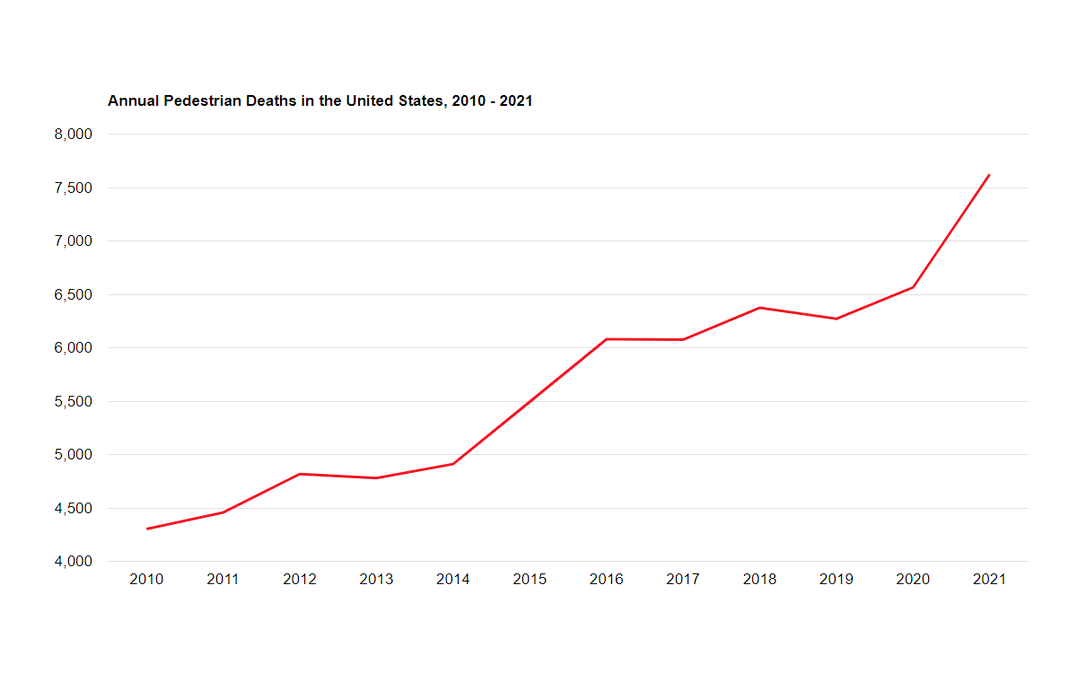Pedestrian deaths have skyrocketed. Is there a solution in sight?

Canva
Pedestrian deaths have skyrocketed. Is there a solution in sight?
A crosswalk signal
At the start of 2023, two students at Virginia Commonwealth University (VCU) in Richmond, Virginia were struck and killed by cars. Mahrokh Khan, a senior at the school, was hit on January 27 while crossing at the corner of Laurel and West Main streets and died shortly afterward.
Just 97 days later, 26-year-old VCU student Shawn Soares was also killed on West Main Street after two cars collided at an intersection. One of the vehicles jumped the curb after the collision, striking Soares, who died on the scene.
Wyatt Gordon, the senior policy and campaigns manager of land use and transportation at the Virginia Conservation Network and a columnist at The Virginia Mercury, worked with Soares at VCU and said that Khan and Soares’ deaths were a wake-up call for Richmond residents. “It really drew a lot of attention to the issue here locally,” Gordon told Automoblog. These deaths are two portions of a troubling trend of increasing pedestrian injuries and deaths in cities across the U.S.
Automoblog dives into the alarming rise in roadway-related pedestrian deaths.
![]()

Automoblog
Pedestrian deaths have risen in recent years
A Line Chart about Annual Pedestrian Deaths in the United States, 2010 – 2021
According to a 2022 study by the Governors Highway Safety Association (GHSA), there has been a 77% increase in pedestrian deaths across the country since 2010. New Mexico ranked as the deadliest state for pedestrians in 2022, with a rate of 4.4 pedestrian deaths per 100,000 people. Virginia had 169 pedestrian fatalities in 2022, a year-over-year increase of 35%.
The most common factors in these situations are, according to Gordon, “speed and road design.” Because the U.S. is a car-centric country, roads often aren’t designed with pedestrian safety in mind. When speed limits on roads that are already unfriendly to pedestrians exceed 25 mph, the danger for pedestrians increases exponentially.
Who or what is to blame for pedestrian deaths?
There’s shared blame for the massive spike in pedestrian mortality rates. While it’s easy to point fingers at government officials for lax laws or at automakers for building oversized vehicles, the actual cause of rising pedestrian fatalities may be more nuanced. Everyday Americans aren’t blameless either, showing that there are multiple layers to the root cause of pedestrian deaths.
Cities aren’t updating their roads
In one sense, municipalities themselves bear responsibility for the uptick in deaths. “Cities across the U.S. have data about where people are dying and why people are dying, but then [they’re] not doing anything about it,” Gordon said. “[Almost] every city in America has what’s called a high injury network. Basically, they’re using DMV data to map out where crashes and fatalities are occurring.”
Elected leaders may be prioritizing other issues in their cities, or they may face opposition from residents who don’t want to see their roadways altered. Some places, like New York City, have set up commissions to study the causes of pedestrian deaths. However, initiating studies and making statements are only helpful to a certain degree. “You don’t have to be a rocket scientist to understand what makes an intersection safe or unsafe to cross,” Gordon said.
“Are you crossing six lanes of traffic to get to the other side of the road? That feels way less safe than crossing two lanes. Are you [crossing] on a raised crosswalk that elevates you, helps you to be seen, and forces drivers to slow down? Do you have enough time to cross the street? Are you given 18 seconds across six lanes of traffic or a full minute? All of those things contribute to how safe an intersection is and how it feels to people.”
Vehicles keep getting larger
Another share of the blame may lie with auto manufacturers themselves. As cars continue to grow in size, the dangers faced by pedestrians increase in tandem. “A decade ago, if you looked at the American car market, it was 75% sedans and 25% SUVs and trucks. And today, that’s fully flipped,” Gordon explained.
He offered a comparison: “Before, you might have gotten hit by a Toyota Camry going 25, which [may have thrown] you up on the roof. If you’re a relatively healthy person, you would have survived. Now, when you get hit by a Ford F-150 where the top of the grille is, in some cases, 5 or 6 feet high – you’re going under. There’s like a 0% survival rate if you go under a vehicle. It’s essentially death that’s guaranteed by design.”
Carmakers are incentivized to make larger cars
In 2015, SUVs outsold sedans for the first time since their introduction. By 2019, they were outselling sedans two-to-one. There are a few factors that have contributed to the popularity of larger vehicles, but it mostly boils down to what Gordon termed an “arms race.”
People who may have preferred to drive smaller, more fuel-efficient cars see large numbers of enormous vehicles on the road and start to feel unsafe. When it comes time to purchase a new car, rather than sticking with a more compact vehicle, they may decide – perhaps out of fear for their own safety – that it’s time to level up.
Car companies make higher profits from selling SUVs and trucks, so they’ve started prioritizing building those types of vehicles over sedans. Larger cars often cost about the same to produce, but they sell for significantly higher prices.
Consumers may also enjoy the added cargo and cabin space afforded by larger vehicles, but, as Gordon put it, “It’s not like Americans just have these vehicle preferences out of nowhere.” Combine the constant endorsement of beefed-up vehicles from advertising with the soft peer pressure of an increasingly homogenous fleet of massive trucks and SUVs, and people gravitate toward these larger options.
Additionally, corporate average fuel economy (CAFE) standards exemptions have allowed car manufacturers to reclassify large vehicles as “light trucks.” Light trucks have more lenient fuel efficiency standards compared to sedans and other small vehicles, so automakers have been making larger cars to avoid the stricter criteria. This loophole for light trucks, which has been on the books for decades, may help to explain the sizing up of American cars.
Is there a solution in sight?
A long-term solution to rising pedestrian fatalities seems far off. Carmakers have wholeheartedly embraced large vehicles and consumers continue to purchase them. The city of Richmond put several speed bumps in place on VCU’s campus and has narrowed certain roads to build protected bike lanes. “Any time you make the road narrower, it’s just naturally [safer],” Gordon said. “You feel like you have less room to maneuver and you slow your speed down.”
Gordon also reports on traffic and urban planning issues in Washington D.C., and said that the city has experienced success in protecting cyclists and pedestrians. “D.C. has pushed through a ton of bike lanes since the start of the pandemic. They’ll do pilots where basically, they just put out cones to create the bike lane. There are the added benefits of actually helping people to have safe alternatives to get around, but they’re really just [thinking], ‘This is a way to reduce crashes. This is a way to reduce the number of people dying on our streets.'”
In Virginia, legislation has been enacted to increase pedestrian safety on the state’s streets. Delegate Betsy Carr of Richmond introduced HB 1903 in 2021, which would allow local governments to enact speed limits below the previous minimum of 25 mph. The bill passed the state legislature and was signed into law by former Gov. Ralph Northam. Now, some Virginia cities and towns can lower the speed limit to 15 mph, dramatically reducing risks of injury.
What the issue really comes down to, however, is whether the public has the appetite to inconvenience themselves on the road to save pedestrians’ lives. “We have to shift our culture as a country to actually caring what happens to the people around us,” Gordon said.
This story was produced by Automoblog and reviewed and distributed by Stacker Media.





